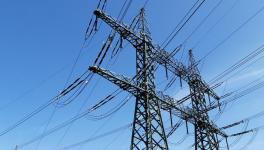Grid Collapses: An Early Warning of the Crisis in the Power Sector
The Northern Grid collapse in the early hours of 30th July and again the next day, this time taking down the Eastern and the North-eastern Grid as well, has brought out only a few issues of the sector. Many others have yet to surface. Any body familiar with the power sector knows that it is in a deep and a multi-faceted crisis. There is the crisis of supply being woefully short of demand, a lack of investments in the transmission network or what is known as the grid, a lack of fuel supplies and a huge overhang of loans on the sector, which cannot be paid as the distribution companies are not able to pay their bills.
We had warned in these columns that the Indian economy is entering into a crisis, which will start with the power sector. This indeed is coming true dramatically with two grid collapses on successive days. While one could give India the benefit of doubt if the grid collapse was an isloated event that happened once in 10 years, this myth is difficult to sustain when two collapses take place on two successive days.
Though over-drawing by UP, Punjab and Rajasthan are being blamed for the black-outs, it is difficult to believe this story. The fact is that it is raining for the last few days and the peak demand on the grid has actually come down. Coupled with the fact that the grid instability started in the early hours of 30th July, it is even more unlikely that the peak demand shot up suddenly at 2.30 AM and certain states started over-drawing then.
The major reasontrigger for the failure of the grid was the tripping on 30th July of the 400-KV Bina-Gwalior line, feeding the Agra-Bareilly transmission section. Without a more detailed analysis, it is difficult to pin-point why this transmission line tripped , but this tripping was more likely due to a local short-circuit.
The key issue is however not the tripping of a particular transmission line. For the entire grid to go down, other factors had to be present as well, as grids are designed to withstand the failure of a transmission link. Two other significant factors would need to be present for a grid failure. The grid must have been already unstable at that time and the other, the relays that operate to separate different parts of the system in order to isolate the unstable portion of the grid, did not act in time. The fact that the grid collapsed again the next day shows clearly that the system currently is operating in an unstable state – there are deeper factors behind the grid collapses than the simple story of unruly states overdrawing from their share. Otherwise, we would have had grid collapses every day during the summer peak, when states continuously violate grid discipline.
If we listen to the private industry, they have already started signing their song – more liberalisation, less regulation, more market driven policies and even more nuclear power. How any of this is related to the grid failures is of course not explained. I am sure that learned economists and business analysts will now proclaim how more FDI's, particularly in retail, will solve India's power crisis. The fact is it is precisely the abandonment of regulation and planned development of the sector that has lead India's power sector into this sorry pass.
Let us go back to 1991, when India introduced its much vaunted liberalisation under Manmohan Singh. The power sector was an immediate target of this liberalisation. It was argued that all we had to do to overcome power shortages was to invite private generators and design a set of policies to entice them to invest. The net result was private players seeking fixed Power Purchase Agreements at inflated prices, of which Enron was of course the prime example.
While the worst excesses of private power may have been mitigated somewhat due to the Enron fiasco, some of the lasting damage to the power sector continues till today. Some of these are abandonment of planning, imports being freed and even encouraged over domestic manufacturing, withdrawing state investments in the power sector in the belief that private sector will step in, and starving transmission and distribution sector of funds.
In the three 5-year plans after liberalisation, the results were visible – the only serious increase in generation came from NTPC. The private players put in very little. As a consequence, while China was rapidly increasing its generation, India in the same period was slowing down – it put in each of the three successive 5-year plans less than what it had put in the 7th 5-year Plan. This is the cause of the shortages today – we are paying for not putting in public investments in the power sector in the religious belief that the market will deliver.
In order to insulate the private players from the problems of the power sector, successive governments – both NDA and UPA – designed the strategy of hiving off generation from transmission and distribution, and then of offering coal mines and bank loans to private players.
The problem of the power sector is that it is distribution which is the key – we need to cut losses, improve transmission and distribution and finally devise a tariff policy that will allow the sector to make enough to keep itself running. Hiving off generation for private players and NTPC, while the states are burdened with the distribution and the more difficult part of the problem, is not a solution. The reason the central government put all its clout behind this “unbundling” of the sector was simple. One is that it was fully convinced that the Thachterite reforms of separating generation , transmission and distribution -- “competition” between generators – was the way to go. The second reason is that Central Government runs NTPC, which operates as an Independent Power Producer (IPP), very much the way that a private player operates. Its vision therefore of the sector is one that favours the IPP's over the interest of the sector as a whole. As the major political parties at the centre – BJP and the Congress – quite often do not run the state governments, they are also quite oblivious of the problems of the states.
The undoing of the electricity sector in India was the Electricity Act of 2003, which made unbundling and removal of cross subsidies the objective of the sector. I still remember one of the architects of the Electricity Act, Gajendra Haldea, who still infests the Planning Commission as an advisor to Montek Singh Ahluwalia, claiming that his objective was to make it possible for electricity to be traded like soap. The grid collapses on two successive days must now convince everybody that electricity is not like soap – the electrical system, unlike soap, has no storage and must always balance between supply and demand. Without this, we have what happened – a grid collapse.
With separation of generation from the rest of the system, the private operators were willing to come in but wanted three major concessions. One was guaranteed availability of coal. That resulted in the coal scam which CAG has now exposed. The private players were given captive coal mines, effectively insulating them from the market price of coal. The second was removing all import duties in the name of mega power projects; this has lead to imported equipment being much cheaper than indigenous equipment as there are duties of various kinds on import of raw materials and intermediate products. We now have about 30,000 MW of cheap Chinese plants that have come or are coming into the Indian grid. The third was easy loans from the public sector Indian banks to bankroll their projects.
All this means that a private player does not need to invest his capital into “his” projects. He takes loans from banks, orders equipment abroad and re-cycles through over-invoicing his share of capital for the project. That means before the project has even started, the private investor has taken his money out. If the project survives, he rakes in more money. If it does not, he can walk away as it is now the bank's problem, therefore a national problem. This is what Mallya is doing with Kingfisher – if Kingfisher Airlines sinks, it is the Bank’s problem. If he has sunk any money, he has already taken it out in other ways. In any case, his real money-spinning business of liquor and real estate is untouched by all the mess he has created in Kingfisher Airlines.
While the government has bent over backwards to promote private players in generation, the transmission sector has been treated with utter disdain. The net result is that while plants have come up, the evacuation of power from such plants is not taking place as the transmission links do not exist or are under capacity. And as the grid collapse shows, the existing transmission lines are already over-loaded,leading now to an unstable grid.
The problem of de-regulation and a weakening of the grid is a consequence of this “unbundling” philosophy. Even in the US, one of the reasons for the grid collapse that took New York and a large part of the US grid out was traced to lack of investments in transmission.
A number of new plants have come up – some with either private generators or with private turn-key supply, erection and commissioning of the plants. A number of them are idling as the Chinese equipment has failed to perform up to standards, either through faulty equipment or faulty erection/commissioning. Further, some of the private players have shut off their plants as they are not getting paid. Some other plants are not able to evacuate power. Some plants are idling due to a lack of coal. If we look at the power sector toady, it is not just absolute shortage of generating capacity that we are looking at but also various other bottle-necks. And having plants idle – for whatever reasons – under conditions of scarcity is criminal.
The problem with the current UPA Government is that it is completely ideologically driven. It does not care what the real problems are. It sees in every crisis an opportunity to push its liberalisation agenda.
Not surprisingly, the demand has already been raised that private players should be encouraged further, even if they have installed substandard equipment and are therefore unable to either commission or run their plants. A new demand for nuclear energy to meet the shortage of electricity – never mind its price or risks – is also being raised.
What be buried is a critical analysis of why did these grid collapses take place and what are the measures to be taken to safeguard the grid and the power sector? This requires a fresh look at the actual problems of the sector and not the make-believe ones of “over-regulation” or some “naughty” states not playing by the rules.
Get the latest reports & analysis with people's perspective on Protests, movements & deep analytical videos, discussions of the current affairs in your Telegram app. Subscribe to NewsClick's Telegram channel & get Real-Time updates on stories, as they get published on our website.























